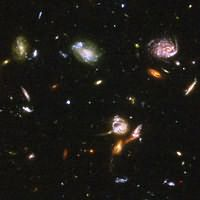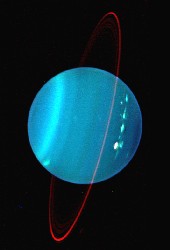|

Club Address:
65-1158 Mamalahoa Hwy.
Kamuela, HI 96743
An electronic publication of The West Hawaii Astronomy Club -
Club Officers:
Co-Presidents:
Craig Combes,
Craig Nance,
Doug Summers
Secretary:
Laura Kinoshita
With Support From:
Canada-France Hawaii Telescope and
W. M. Keck Observatory
This website is currently maintained by
Doug Summers

|
|
|
April 2006 Club Meeting Report
Agenda:
| | Welcome / Greetings |
Laura Kinoshita/All |
10 min |
| Show and Tell |
All |
15 min |
| Stardust Mission |
Laura Kinoshita |
15-20 min |
| Featured Topic: Planet Building in the Orion Nebula |
Dr. Marc Kassis, W. M. Keck Observatory |
30 min |
| Night Sky Network: Black Holes |
Laura Kinoshita |
15 min |
| Astronomy Podcasts: Introduction and Take-Home Item |
Laura Kinoshita |
10 min |
| The Sky This Month |
Craig Nance |
15 min |
| Club Business |
All |
10 min | ^M
| Open Discussions/Socialization/Fun | ^M
All |
Finish by 9:00pm |
The April meeting was held on April 11, 2006 in the Keck Hualalai Conference Room.
The meeting began at 7pm with Laura Kinoshita facilitating the meeting. Thanks, Laura!!
We had 18 members in attendance on a wet, rainy Waimea evening, following about a month of wet, rainy weather. One new member was welcomed! There was some discussion that we should arrange to have cookies and coffee/tea for the WHAC meetings at Keck. Any volunteers?
- Some brief announcements were made at the start of the meeting. Neil Paulsen mentioned that there will be a Girl Scout event occurring over the Memorial Day weekend at the Kilohana Girl Scout Camp. The camp is located at approximately Mile Marker 44 on the Saddle Road, 9.6 miles mauka from the Saddle Road Junction. Paul reports that the camp has very dark, quality skies. The details of this event will be posted on the WHAC web site and through our Yahoo group web page.
- Craig Combes mentioned that there will be a "Waimea Healthy Keiki Fest" on Saturday April 29 in Waimea. There is the opportunity to set up a table to promote the club. Interested persons should contact Craig Combes directly.
- For the Gear Show and Tell, Craig Combes presented a Burgess Optical 5mm planetary eyepiece, which he has never used and would like to sell for $80. The eyepiece is new-in-box and comes with a 100% satisfaction guarantee. See Craig Combes if you are interested in this eyepiece.
Craig also presented his new Palm TX which has the Astromist software. This makes it possible to drive any telescope having an autostar controller. The software was only $26! Craig summed it up in one word…"incredible". See Craig Combes to learn more.
- Craig Nance then presented the reason for the heavy rains of the past month, his new 4.25" f/4 Rich Field Telescope (RFT).
The primary mirror for the telescope was bought on a whim from Apogee Inc. Craig made a mirror cell from plywood, screws, and springs. The focuser and single-vane secondary was stuff he had lying around his shop. The red anodized tube was bought years ago at a salvage sale. It only took a weekend between other chores to build. He uses a 26mm eyepiece which gives an actual field of view slightly larger than 3-degrees, or six Full Moon's in diameter. There is no mount; you cradle the telescope in your arms and sweep the sky. Craig built it primarily to observe the Milky Way. It allows the observer to see objects within the larger grandeur of the night sky, by viewing objects in context with the surrounding sky. All are invited to try it out at the upcoming star parties.
- Doug Summers presented an air mass calculator which can be found on the WHAC web site, in links. Pierre Martin mentioned that there is also a relationship of seeing versus elevation as well; that seeing degrades dramatically as zenith angle increases.
- Laura Kinoshita presented information about the Stardust mission. She began with a short video clip detailing the flight of the mission to comet Wild 2. The spacecraft captured microscopic particles of cometary dust within an aerogell collector. The original plan was to use automated image recognition software to analyze the aerogell collector looking for the presence of dust particles. The analogy is trying to find 45 ants within a football field sized area, looking at the ground in 2" x 2" sections. Turns out that the image recognition software doesn't work as well as expected. Instead, the Stardust team seeks volunteers to perform this work.
You can go onto the Stardust web site to learn more about the program and volunteer if you wish. You will be tested on your ability to recognize the tracks the particles leave behind. Having passed the test, you will be given a score, a password, and access to the actual microscope data. The volunteers will comb the data looking for particles. The first person to find a particle will have naming rights to the particle, and other rewards! Laura has taken and passed the test, and is awaiting the release of the data to start looking for real particles. She found it to be fun and addictive, much like a video game.
Dr. Marc Kassis of the Keck Observatory was the featured speaker of the evening. He is part of a team that is researching the proplyds in the Orion Nebula using Hubble, Keck, Gemini, and other data. He showed that the Orion Nebula is peppered with little dark spots. These are proto-planetary systems, or proplyds, for short. They have various shapes and sizes, some even having disks and jets. He showed how the Trapezium stars are driving the activity of the Orion Nebula, particularly the brightest star "C". Marc showed arcs between C and a few of the nearer proplyds. These arcs are shock waves caused by the intense radiation from C interacting with the proplyd. Marc said that by studying the proplyds, it gives insight into the environment in which our Sun formed. The Sun was likely formed in a region similar to the Orion Nebula, and the protoplanetary disk of our Sun was likely exposed to intense UV radiation as well. Marc and other researchers prefer to use thermal IR wavelengths because the disks are brightest at these ~10-micron wavelengths. Marc shared an incredible morphing video from a HST visible light image of the Trapesium area into a thermal IR image. The IR image was taken by the T-ReCS instrument on Gemini South. The main conclusion of studying the Orion Nebula is that they find it is possible to form planetary systems in these chaotic regions, even in the presence of massive stars and supernovas. Everyone was grateful for Marc coming and sharing this information with us! The scribe notes that Marc was featured in a recent news bulletin in Sky & Telescope magazine on this very subject.
After Marc's talk, there was discussion about how spectacular the Orion Nebula appears to us from the Earth. But, the Orion Nebula is not a spectacular H2 region as compared to others. The only reason it appears dramatic to us is because it is only 1,500-lya. Its proximity is what makes it an exciting object to study. Pierre indicated that the largest H2 emission nebula known in the Milky Way is W49, located in Aquilla. But, put away your telescopes, W49 is unseen from Earth using visible-light wavelengths because of the dust in the Milky Way. There is a lot of information on the Internet about W49. If the Tarantula Nebula, an H2 region in the LMC, were as close as the Orion Nebula, it would be visible during the daytime as large as the Moon!
- Craig Nance presented The Sky This Month, and the Featured Object of the Month. There are many public outreach opportunities the coming month. AstroDay is at the top, along with many others. Craig shared information about the approach of comet, or comets, 73P/Schwassmann-Wachmann-3 (say that fast three times!). Closest approach is May 12 in the morning sky. Should be an awesome show, not to be missed! Craig then presented the Whirlpool Galaxy, M-51, as the Featured Object for the month.
- Laura shared an interesting demonstration courtesy of the Night Sky Network. It is possible to model gravity wells and black holes using a bucket, a bungee cord, some cloth, and a few marbles of various sizes. It is quite fun to send a marble in orbit around a gravity well!
- Next, Laura shared with us information about astronomy podcasts. These are radio shows that are available for download from the internet. The idea is that you can download these shows into your portable audio player. These players are known as iPod if Apple makes them, or more generically as MP3 players. Laura gave everyone a CD with several astronomy-related radio shows on them. Among the most popular is www.SlackerAstronomy.org. Laura mentioned that the public lectures on astronomy held at Keck are available on the Keck Observatory homepage somewhere.
- Carlton Lane reported on the total solar eclipse he viewed from Turkey. As proof Carlton is a true solar eclipse veteran, he reports that the eclipse was not that good. He reported that there was high haze in the sky which prevented them from seeing planets in the sky during the totality phase. And, there were no significant prominences visible. The scribe notes that the next good total solar eclipse will be July 22, 2009 in the western Pacific, including China and the southern fringes of Japan.
Business...Nah! We decided not to discuss club business as we were running a bit past 9pm, and most things were discussed already. As always, pay close attention to the WHAC web site and the WHAC Yahoo groups page for club news and information.
Meeting adjourned at 9:15pm!
Reminder that the next meeting is May 9, 2006 at the CFHT HQ at 7pm. All are invited to the customary pre-meeting casual dinner at the Parker Ranch Food Court starting at ~6pm.
The meeting concluded in time for discussions and a look at the Virgo cluster transparencies. At the end of the meeting, several items (a Subaru calendar, and a couple of software titles) were given away.
Previous meeting minutes:
|


